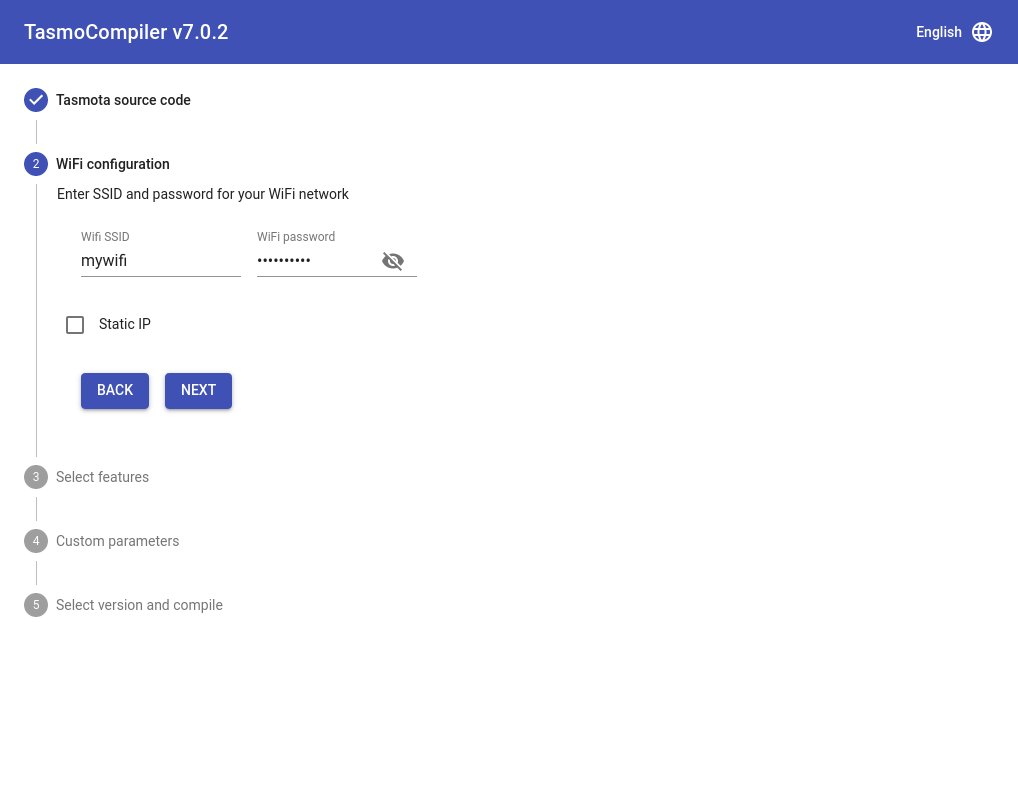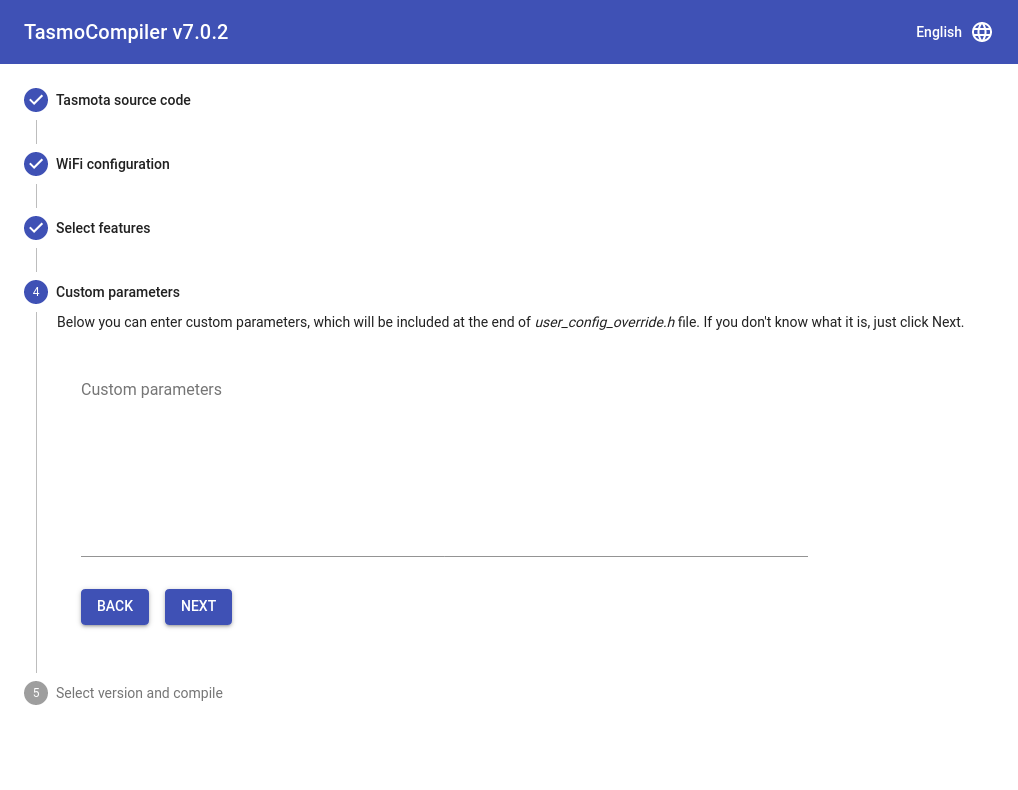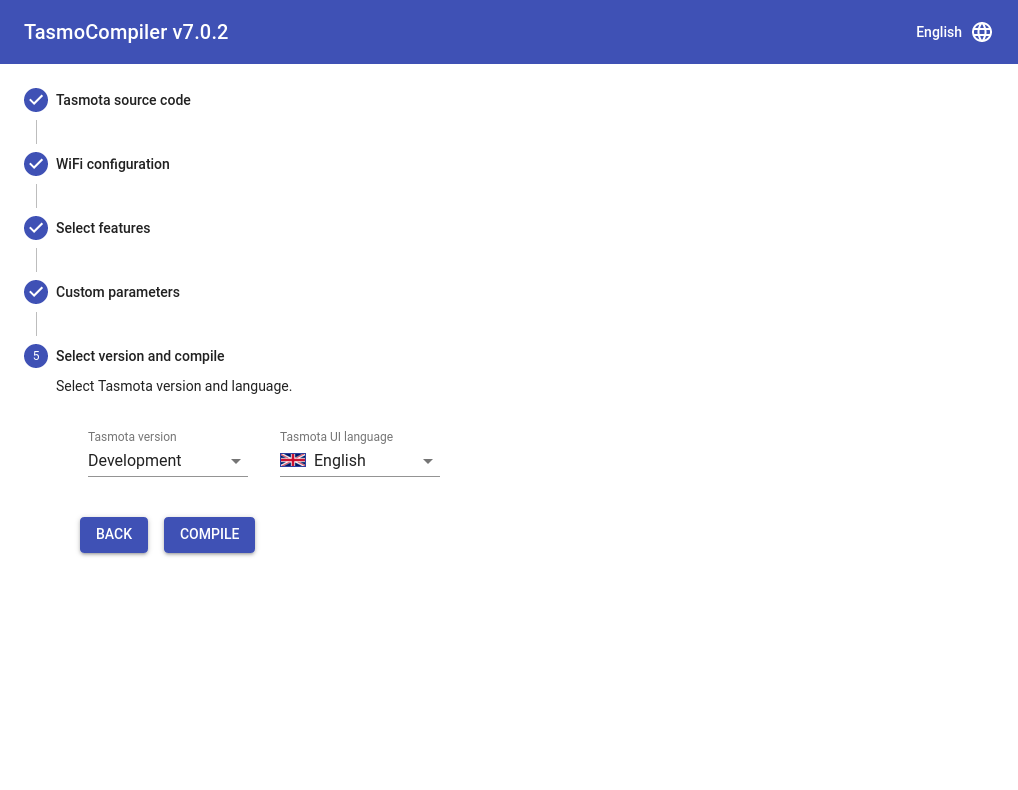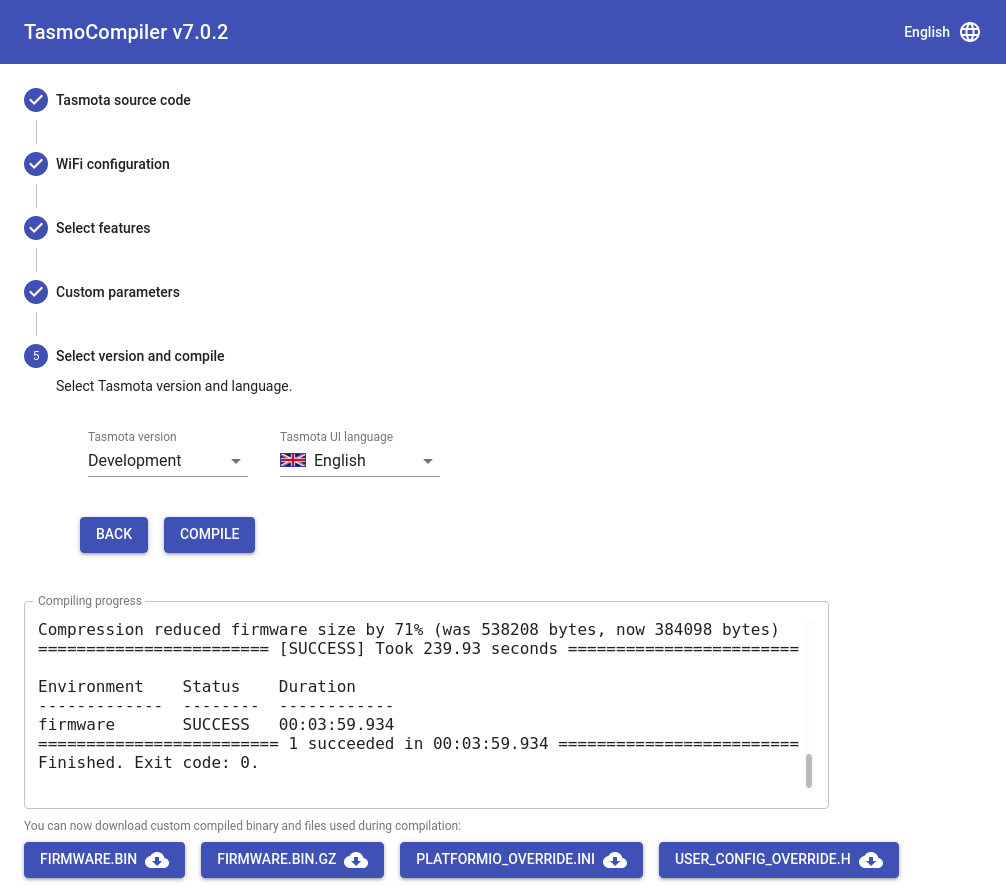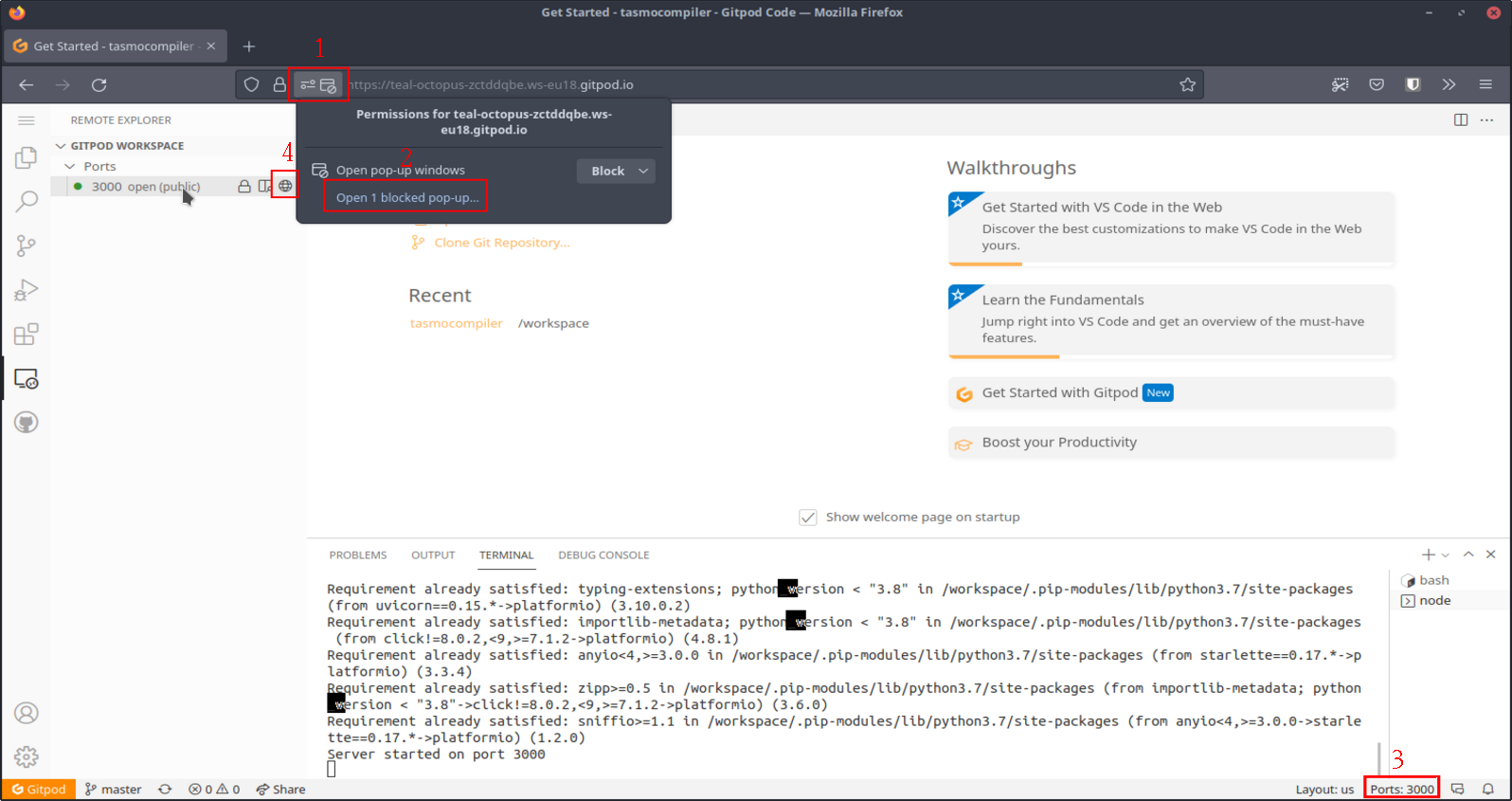benzino77 / Tasmocompiler
Programming Languages
Projects that are alternatives of or similar to Tasmocompiler
What it is?
TasmoCompiler is a simple web GUI which allows you to compile fantastic Tasmota firmware with your own settings:
- You can select which features/sensors of Tasmota firmware you want to use
- Credentials for your IOT WiFi network, so even after unexpected problems with the device (complete lost of configuration), credentials for your network will still be there, but mainly you don't have to connect to AP, served by Tasmota to configure your Home WiFi
- You can select Tasmota version you want to compile. You can select
developmentbleading edge version, or ie. previous stable release6.4.1or6.2.1if this is the one you like - You can also select with what Core version you want to compile your custom firmware: 2.3.0, 2.4.2 or maybe 2.5.0
- Hardware version (Sonoffs, Wemos, NodeMCU).
- Language version
- You can also provide custom
#definesif you want to build even more suitable firmaware for your needs
Why?
Well, there are two reasons. First is that I want to build my first application written in NodeJS/React. The second one is based on the observation that everytime I prepare a new device I have to start atom with platformio installed, configure all #defines (well, I have template which I copy) and prepare platformio.ini, create a branch from version I like to use, etc..
That's why I decided to prepare a solution which is easier to use (just a few clicks) and does not require knowledge how to install dev environment to build custom firmware.
How it works?
The easiest way is to look at the screenshots (the whole process is five steps only). After compilation you will be able to download three files:
- Your new
firmware.binfile, which can be uploaded to your device via Tasmota WebGUI, espotool, ESPEasy flasher or any other tool you used to use to flash your device -
platformio.inifile, to check what options for platformio were used to compile the custom firmware file -
user_config_override.hfile to check what features are included/excluded from resulting firmware
The links to download these files will show up under Compiling progress field (look at the bottom of the last screenshot). These links will show up only when compilation is successful.
You have to upload only the first firmware.bin file to your device. How to do that is perfeclty described on Tasmota wiki.
How to start using TasmoCompiler?
Super easy way (Thanks to @meingraham and @Jason2866)
Click this link to Gipod. You have to have Github account and authorize Gitpod to access it. If you don't have it, it is just few clicks to create account on Github. After a while new browser tab should open with TasmoCompiler. If you have pop-up blocked in your browser you will have to accept the new tab open. If the new tab does not open or you cannot see the pop-up notification, click on the Open Browser link:
Note
You have to remember that all compilation is performed on Gitpod servers, so you have to decide if you want to put sensitive data like Wifi/MQTT credentials to Gitpod hands 🙈 🙉 🙊
Easy way
Start TasmoCompiler in docker:
docker pull benzino77/tasmocompiler
docker run --rm --name tasmocompiler -p 3000:3000 benzino77/tasmocompiler
Then point your browser to http://localhost:3000
If you want to see debug messages on docker console you can run a container with env variable:
docker run --rm --name tasmocompiler -p 3000:3000 -e DEBUG=server,git,compile benzino77/tasmocompiler
-
serverto see http server messages -
gitto see git operation messages -
compileto see messages during compilation
You can also specify different port on which TasmoCompiler will be available on the host:
docker run --rm --name tasmocompiler -p 8080:3000 benzino77/tasmocompiler
Then point your browser to http://localhost:8080
Less easy way
- Install
NodeJSandPython 2.7.x - Install
yarn - Install
platformio - Clone/download the repository from github and change directory to the cloned repo
- run
yarn install - run
yarn build - run
node server/server.js - point your browser to http://localhost:3000
How to use "Custom parameters"?
The configuration options are limited on purpose. I don't want to overload the GUI with too many options. But there is Custom prameters step which allows you to define other Tasmota parameters. Let's say you want to define your MQTT broker and credentials for it. You have to put these lines in Custom parameters field:
#ifdef MQTT_HOST
#undef MQTT_HOST
#endif
#define MQTT_HOST "mqtt.yourhost.iot"
#ifdef MQTT_PORT
#undef MQTT_PORT
#endif
#define MQTT_PORT 1883
#ifdef MQTT_USER
#undef MQTT_USER
#endif
#define MQTT_USER "mqttuser"
#ifdef MQTT_PASS
#undef MQTT_PASS
#endif
#define MQTT_PASS "mqttpassword"
To define Friendly name for your device you have to put these lines in Custom parametrs field:
#ifdef FRIENDLY_NAME
#undef FRIENDLY_NAME
#endif
#define FRIENDLY_NAME "Watering controller"
Let's assume that you want to compile in information about your ntp server, your time zone and location (this is used by timers for events like sunrise/sunset). You can do this by putting these lines in Custom parameters field:
#ifdef NTP_SERVER1
#undef NTP_SERVER1
#endif
#define NTP_SERVER1 "ntp.yourserver.iot"
#ifdef LATITUDE
#undef LATITUDE
#endif
#define LATITUDE 34.4348
#ifdef LONGITUDE
#undef LONGITUDE
#endif
#define LONGITUDE 10.0508
#ifdef APP_TIMEZONE
#undef APP_TIMEZONE
#endif
#define APP_TIMEZONE 99
You can find additional inforamtion what can be set by Custom parameters field in my_user_config.h in Tasmota source code.
Troubleshooting and advanced usage
If you have problems with the compiler or you are interested in more advance usage, please refer to the ADVANCED tips for more information.
Disclaimer
Everything you do, you do on your own responsibility. I do not take any responsibility for damages or problems, that may arise as a result of using this solution or its products.
Credits
Thanks to Theo Arends and the entire Tasmota Dev Team for fantastic work!
License
TasmoCompiler is licensed under the MIT license.






